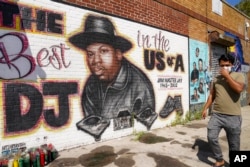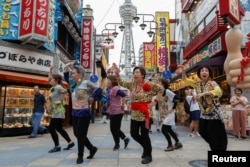The signs of hip-hop’s influence are everywhere. American rapper and music producer Pharrell Williams recently became a creative director for the French fashion company Louis Vuitton. Other hip hop stars, including Dr. Dre, Diddy and Jay-Z, started billion-dollar fashion, lifestyle and music companies.
But it did not start out that way.
Hip-hop started 50 years ago as an escape from the poverty and violence in the Bronx area of New York City. The music and style appealed to Black and Latino teenagers. As hip-hop spread throughout New York, so did the culture.
People often mix up hip-hop with rap. Rap is a musical style that combines quick recitation of rhymes with musical beats. But hip-hop is more than just music. It is a culture, and rap music is one part of it. Hip-hop also includes other activities, like breakdancing, disc-jockeying and graffiti art.
In his 1993 song Hip Hop vs. Rap, KRS-One said: “Rap is something you do. Hip hop is something you live.”
In the early days of hip-hop, playing music on the streets or turning a basketball court into a dance floor may have seemed like a simple invitation to have fun and party. But it actually was an answer to social and economic injustice in poor neighborhoods. It was a way to show joy and imagination even without resources and wealth.
As hip-hop and rap music grew into a force in American culture, entertainers used it to speak to their personal realities. In 1982, in the song The Message, Grandmaster Flash and the Furious Five denounced poverty and a lack of investment in Black communities. Several years later, Tupac Shakur railed against police violence in the song Changes.
Today, hip-hop’s influence on music and other industries is so widespread that experts say it becomes difficult to measure. Writer Zack O’Malley Greenburg estimates that hip-hop’s five wealthiest artists were collectively worth nearly $4 billion in 2022.
There is also hip-hop’s influence on protest, resistance and political dissent around the world. From the Arab Spring and the Palestinian freedom fight to feminism and class struggles, rap music is a popular expression for calls to action. Music videos produced by artists in Africa, Europe, Asia and South America often include breakdancers, graffiti and other elements of hip-hop.
In 2016, former U.S. President Barack Obama answered questions about human rights and free expression during a visit to Vietnam. One question came from Suboi, a female rapper known as Vietnam’s “Queen of Hip-Hop.” She said she struggled against the Vietnamese stereotype that rap and hip-hop music are not a good form of expression for Asian women.
“Let’s be honest, sometimes art is dangerous and that’s why governments sometimes get nervous about art,” Obama said. “But one of the things that I truly believe is that if you try to suppress the arts, then I think you’re suppressing the deepest dreams and aspirations of a people.”
American civil rights leader Rev. Al Sharpton was 18 years old when hip-hop took off in his native New York. He said rap music fueled the movement that has shaped much of his public life. Now 68 years old, Sharpton said he believes hip-hop culture was part of what made it possible for the United States to elect its first Black president in 2008.
“Hip-hop took the chains off us and said, ‘No, we’re gonna say it our way, “ Sharpton said, “It was that freedom. It was that raw, non-watered down kind of expression.”
I'm Caty Weaver.
Hai Do adapted this story for Learning English based on reporting from The Associated Press.
_________________________________________________
Words in This Story
fashion - n. the business of creating and selling new styles of clothes
teenager - n. someone between 13 and 19 years old
recitation - n. the act of describing or listing many things in a series
rhyme - n. words or phrases that end in the same sound
disc jockey - n. a person who plays recorded music on radio, at a party or a night club
graffiti - n. pictures or words drawn on a wall
chain - n. metal links or rings usually used to attach to a prisoner














Forum